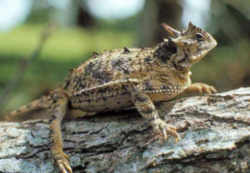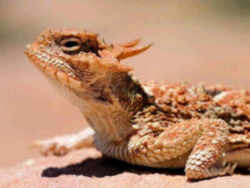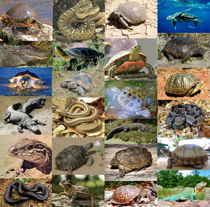
Texas Symbols
Texas State Reptile
Texas Horned Lizard

(Phrynosoma cornutum)
Adopted on May 28, 1993.
If Texans couldn't adopt a Texas-sized reptile, they could simply adopt a reptile with a Texas-sized reputation. And they did by House Concurrent Resolution No. 141, 73rd Legislature, Regular Session adopted on May 28, 1993.
The Texas Horned Lizard, (Phrynosoma cornutum,) was adopted when Governor Ann Richards signed House Concurrent Resolution No. 141 on June 18, 1993.
The Horned Toad is the also the Official Mascot for Texas Christian University (TCU) in Fort Worth.
Horned Lizards (in general) play an important role in many Native American cultures. The Horned Lizard is often seen as a symbol of strength and important as a symbol for healing (Pianka and Hodges). In Mexico the Horned Lizard is believed to help bring rain (Manaster 1997).
Texas State Reptile: Texas Horned Lizard

Texas Horned Lizard, also called Horny Toad, Horned Frog and Horn Frog is a flat-bodied and fierce-looking lizard. The head has numerous horns, all of which are prominent, with two central head spines being much longer than any of the others. Horned Lizards are the most fearsome-looking and distinctive by virtue of the pointed, protruding "horns" above their eyes. To the uninitiated, their dragon-like appearance is quite formidable. The squat form and head armor has given rise to the name "hornytoad," "horned toad" and "horned lizards." However, since there is a true toad with horns, it is best that we speak of this genus as the "Horned Lizards."
The ventral surface of the lizard is either gray or tan (Seymour and Royo 1996). The dorsal surface of the lizard is tan or gray with white and red or yellow highlights (Bockstanz 1998). There is a pattern of dark spots on the dorsal surface of the lizard, which correspond to the location of the dorsal spines (Bockstanz 1998).
Life History
The Texas Horned Lizard's intimidating exterior is quite opposite from its docile and gentle nature. They spend their days eating, sunbathing and eluding predators. Their activities are based on an internal biological clock. They emerge from their burrows shortly before sunrise and, with their backs toward the sun, they bask to bring about a fast rise in body temperature. Once properly warmed, they remain active until the time comes to retreat into shaded areas to avoid the most intense heat of the day.
Defense
Horned lizards have a unique repertoir of defense. When threatened, their first reaction is to flatten out and freeze in place. This enable the horned lizard to blend in with the ground as well as reduce the casting of a body shadow. Unfortunately, many horned lizards are killed because they bask on roadways and simply to not move when a car approaches. Another defensive reaction is to run briefly then suddenly stop, seemingly creating the illusion of disappearance. When disturbed or in an extremely agitated state, the Texas Horned Lizard also is capable of inflating its body, hissing, and even squirting blood from its eyes in order to deter predators.
Food Habits
The Texas Horned Lizard eats mainly Harvester ants, Pogonomyrmex spp., but will also eat grasshoppers, isopods, beetles and beetle larvae. In order to obtain enough energy, adult Texas Horned Lizards must forage from several colonies of Harvester ants.
Behavior
The Texas Horned Lizards' daily activities are planned around the times of highest ant activity. (Donaldson, et al 1994)
Hibernation begins in September or October, and continues until late April or May.
Reproduction
Mating occurs soon after emergence. After a receptive female and male mate, the gravid female will carry the eggs for a period of time as they develop. Once a nest site is chosen, she will dig a slanted tunnel and lay 13 to 45 eggs in two to three soil packed layers. After burying the eggs, she may sit on the entrance tunnel for one night, but then she leaves, never to return to the eggs again. Some five to nine weeks later, the baby lizards will hatch and fight their way out of the egg with a specialized "egg tooth."
Habitat and Distribution
Texas Horned Lizards range from the South-Central United States to Northern Mexico. They can be found in arid and semiarid habitats in open areas
with sparce plant cover throughout much of Texas except for the piney woods region in East Texas, Oklahoma, Kansas and New Mexico. As horned lizards
dig for hibernation, nesting and insulation purposes, they commonly are found in loose sand or loamy soils.
The invasion of Texas by the fire ant (Sclerosises invicta) and the consequent extensive use of insecticides in an attempt to control them, has at
the same time reduced the population of harvester ants, greatly diminishing the food supply for the horned lizard. Field surveys conducted in 1992
by the Texas Parks and Wildlife Departmentqv indicated reduced populations of horned lizards in those areas where there is extensive agriculture
and where the use of chemicals continues. Populations of Texas horned lizards are expected to remain stable in South and far West Texas unless major
changes are made in how the land is used. The Texas horned lizard was one of the first animals to be listed as a threatened species in Texas (1977).
The Texas Horned Lizard currently is state-listed as a threatened species (federal category C2).
Texas House Concurrent Resolution No. 141
Texas State Legislature
House Concurrent Resolution No. 141,
73rd Legislature, Regular Session (1993)
WHEREAS, The State of Texas traditionally has recognized natural life forms commonly found within the state as tangible representations of both the
state's proud spirit and its vast and diverse natural heritage by proclaiming them official state symbols; and
WHEREAS, The Texas horned lizard, Phrynosoma cornutum, is well known and much loved by its human neighbors in the hot, arid regions where it makes
its home; and
WHEREAS, Known variously as a horned toad, horny toad, and horned frog, this fascinating creature nevertheless is a true lizard, a member of the reptile
suborder Lacertilia, with a lineage that has been traced back to the days of the dinosaurs; and
WHEREAS, The horned lizard possesses numerous attributes that qualify it for designation as an official representative of our state; despite a spiny
exterior that presents a forbidding appearance, it is at heart a docile and peaceful creature; and
WHEREAS, A skilled hunter, the horned lizard helps to diminish the population of a variety of insect pests; although it prefers a diet of ants, it
also will eat grasshoppers, crickets, beetles, pill bugs, and spiders; and
WHEREAS, Its protective coloration and resourcefulness enable it to escape detection by predators, but when threatened it is able to inflate its body
to frighten its adversaries; and
WHEREAS, Although these characteristics distinguish the horned lizard as a fitting embodiment of our state and its heritage, it is perhaps most appropriate
for designation as an official state symbol because, like many other things truly Texasn, it is a threatened species; now, therefore, be it
RESOLVED, That the 73rd Legislature of the State of Texas hereby recognize the Texas horned lizard as an appropriate representative of our state; and,
be it further
RESOLVED, That the Texas horned lizard be officially designated the State Reptile of Texas.
Raymond
Adopted by the House on May 26, 1993.
Adopted by the Senate on May 27, 1993.
Approved by Governor Ann Richards on May 28, 1993
Taxonomic Hierarchy: Texas Horned Lizard
Kingdom: Animalia - animals
Phylum: Chordata - chordates
Class: Reptilia
Order: Squamata
SubOrder: Lacertilia
Family: Iguanidae
Genus: Phrynosoma
Species: Phrynosoma cornutum







